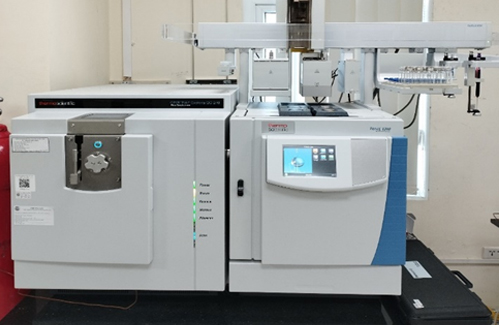- Folder Chemical field
- Views 3028
- Last Updated 22/04/2022

Liquid chromatography tandem mass spectrometry system (Waters XEVO TQ-XS)
Currently, the XEVO TQ-XS is considered as the most sensitive liquid chromatography tandem mass spectrometry system of Waters. The system includes:
- I-Class ultra-performance liquid chromatography
- Triple quadrupole mass spectrometry with ESI and APCI sources
1. Liquid chromatography
Liquid chromatography is a separation that takes place in a chromatography column in which the stationary phase is a solid and the mobile phase is a liquid. It relies on pumps to pass a pressurized liquid solvent containing the sample mixture through a column filled with a solid adsorbent material. Due to the different molecular strucure, the physical and chemical properties, each component in the sample interacts slightly differently with the stationary phase and mobile phase, causing different flow rates for the different components and leading to the separation of the components as they flow out of the column.

LC-MS/MS system modeling
2. Mass spectrometry
Mass spectrometry is an extremely sensitive and specific analytical technique,based on detecting themolecular weight of substances. Ions can be created by adding or removing their negative charges such as deprotonation and protonation,...
All mass spectrometers comprise three maincomponents. First, an ion source, where sample molecules may be ionized by a varietyof means, second, a mass analyzer that separates ions according to their mass-to-chargeratio, m/z, third, a detector that measures the abundances of the separated ions as anelectrical signal, thenconverts the detector signal into aform suitable for further study and processing.

Flow chart of mass spectrometry
- Ion
Analyte after passing the LC column will be directed to an ion source in which molecualar may be evaporated and ionized. Some ionization techniques are commonly used in liquid chromatography mass spectrometry such as: electrospray ionization (ESI), atmospheric pressure chemical ionization (APCI).
a) ESI
The ESI technique includes three steps:
- Generate the charged droplets
- Break up into smaller particles
- Evaporate particles
After passing LC column, the analyte is pumped through a narrow diameter stainless steel capillary tube that is maintained at a voltage in the range of 4–6 kV.When the excess charge on the capillary tip overcomes the surface tension of the sample solution, charged droplets will be generated form.These charged droplets are then reduced in size by two continuous processes, the solvent vaporation by a flow of nitrogen gas and the collision of same charged droplets. Eventually it leads to the vapor phase formation of ions. The ions are sampled through a tiny orifice and enter into the mass analyzer by electrostatic attraction. Solvents and inert gas N2 are sucked out by a stream of gas (Curtain Gas).
b) APCI
Flowing liquid, typically the HPLC eluent that contains analytes will be converted into droplets and then evaporated at high temperature about 500°C. A high voltage of 3 - 5kV generates electrrons and ionize the analyte.
- Quadrupole mass spectrometer
The quadrupole principle is based on that dissimilar mass ions will oscillate diferently according to the direct or alternating voltage that are applied to the rod.
The quadrupole consists of four cylindrical rod, set parallel to each other, forming two pair. Each opposing rod pair connect together electrically with a DC or AC voltage to create two pairs of positive and negative poles. These voltage combinations, especially the AC voltage, will periodically change to scan ions:
+ Ion resonace
+ Ion without resonance
Some ions with certain m/z ration resonance with a given alternating potential will reach the detector. Whereas other ions have unstable trajectories and will collide with the rods. However, in order to obtain all the ions, the voltage is scanned periodically from 0 to a certain voltage and then return to 0. This ensures not only one ion with a particualr m/s is selected but also a range of m/z values.
3. Application of LC-MS / MS Waters XEVO TQ-XS system in the Department of Nutrition and Food Additives
Currently, NIFC has more than 5 LC-MS/MS devices, inwhich, the LC-MS/MS Waters XEVO TQ-XS system is located in the Department of Nutrition and Food Additives and used specifically for analyzing microbiological nutrients at low content and food additives are as follows:
+ Oil-soluble vitamins: vitamin A (retinol, retinyl palmitate ...), carotene (total carotene, beta-carotene), vitamin D (D2, D3), vitamin E (alphatocopherol, tocopheryl acetate, beta-tocopherol, gama-tocopherol, delta-tocopherol), vitamin K (K1, K2, K3, MK4, MK7) ... withAPCI source.
+ Water-soluble vitamins: B vitamins (B1, B2, B3, B5, B6, B9, biotin, B12), ...with ESI soure.
In addition, the system alsocan be used to confirm when the analysis on the HPLC can not, such as: lactose content in free lactose milk, sucrose in products without added sugar, and some groups of additives. Products: parabens, anthocyanin, steviol glycosides ...










-cua-hang-Waters.jpg)








